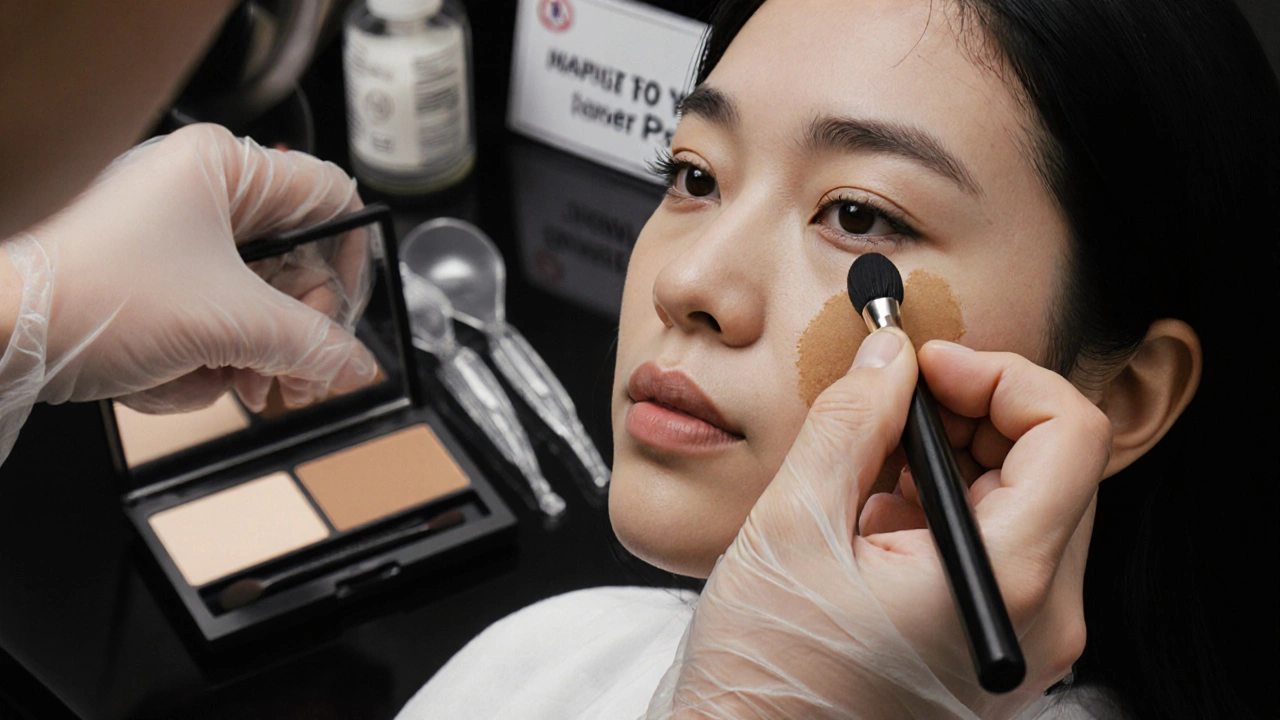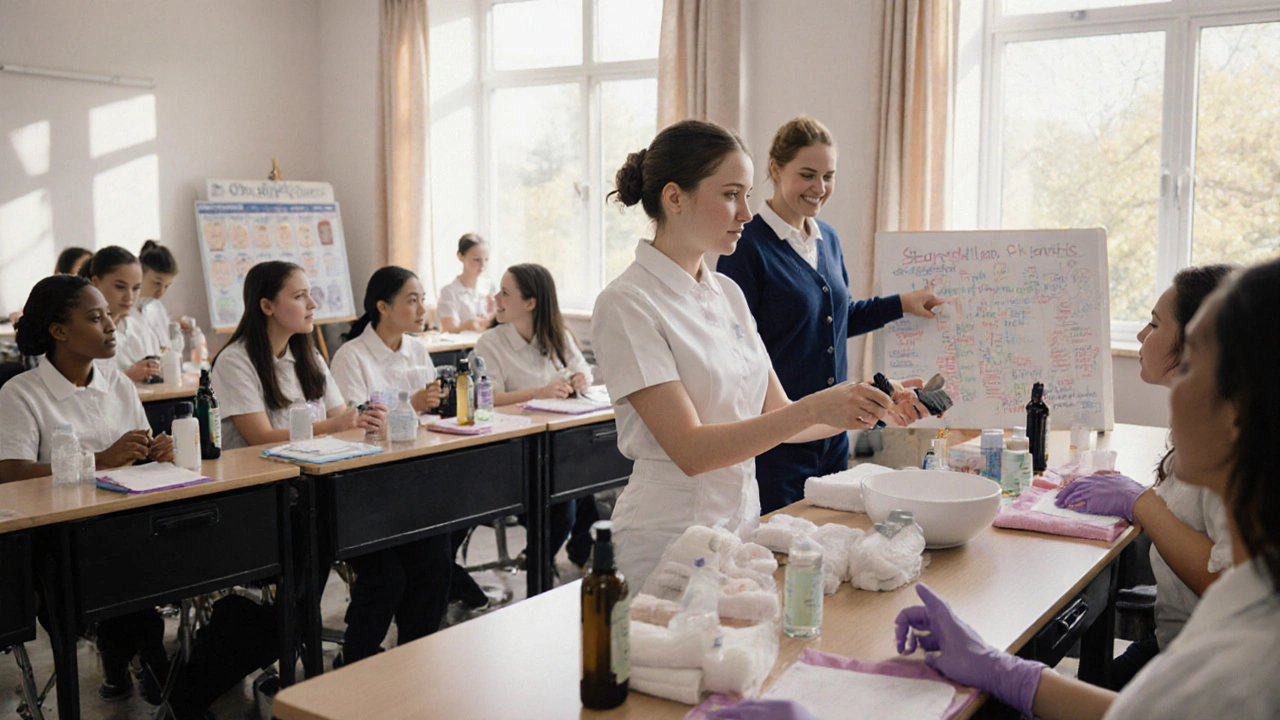Beauty Therapy Salary Progression Calculator
Current Qualification
When you hear the term Level 1 Beauty Therapy is the entry‑level qualification that introduces learners to basic skin‑care, makeup, and client‑service techniques, you know you’re looking at the first step in a professional beauty career.
What Exactly Is Level 1 Beauty Therapy?
Level 1 Beauty Therapy is an introductory credential recognised by the UK’s NVQ (National Vocational Qualification) framework. It sits at Level 1 of the UK Qualifications Framework (the national register that measures the difficulty of learning outcomes). The qualification does not qualify you to work independently yet, but it equips you with a solid foundation in:
- Basic skin analysis and facial treatments
- Simple makeup application
- Introductory hair removal techniques
- Health and safety standards for beauty settings
- Professional client communication
Think of it as the “gym starter pack” for beauty professionals - you learn the moves before you lift heavy weights.
Who Can Enrol?
The course is designed for anyone with a genuine interest in beauty, regardless of prior experience. Typical entry requirements include:
- Minimum age of 16
- Basic English literacy (reading instructions, writing client notes)
- Pass a short aptitude test that checks hand‑eye coordination and customer‑service instincts
- For younger students, parental consent is needed
Because the curriculum is hands‑on, schools often welcome school leavers, career‑change seekers, and even retirees looking for a creative hobby.
Core Curriculum - What You’ll Learn
All programmes follow a similar structure, but the exact wording can differ between providers. Below is the most common set of modules:
- Introduction to Beauty Therapy - history, career routes, ethical standards.
- Skin Care (basic facial techniques, skin types, and product knowledge) - cleansing, exfoliation, mask application.
- Makeup Application (simple day‑to‑night looks, colour theory, hygiene) - foundation, eye makeup, finishing sprays.
- Hair Removal (waxing basics, safety, after‑care) - eyebrows, upper lip, simple leg wax.
- Health and Safety (infection control, risk assessments, personal protective equipment) - cleaning protocols, client consent forms.
- Client Consultation (effective communication, recording client history, managing expectations) - role‑play scenarios, record‑keeping.
Each module blends theory (often delivered through short classroom sessions) with practical labs where you work on real‑life models.
How the Qualification Is Awarded
Upon completing the required hours - usually 100 to 150 contact hours - you undergo assessment by an external examiner from the NVQ. The assessment consists of:
- A written portfolio documenting your practical work, client notes, and health‑and‑safety checklists.
- A practical viva where you demonstrate a facial or wax on a live model while answering competency questions.
- A short written test covering theory and product knowledge.
Pass all three and you receive the official NVQ Level 1 certificate, which you can add to your CV and LinkedIn profile.

Study Options - Where and How You Can Learn
In the UK there are three main pathways:
- Full‑time college courses - 3‑month intensive blocks, ideal if you can commit weekdays.
- Part‑time evening or weekend classes - spread over 6‑9 months, perfect for those working or studying elsewhere.
- Online blended learning - video lectures plus scheduled lab days at a local partner centre. Many Bristol‑based schools, such as City of Bristol College, offer this hybrid model.
When choosing a provider, check that they are Accredited (recognized by the awarding body and the Department for Education) and that they have a dedicated beauty lab.
Costs and Funding
Fees vary widely depending on location and delivery mode. As of October 2025 the typical price range is:
- Full‑time: £800‑£1,200
- Part‑time: £1,000‑£1,500 (includes additional lab fees)
- Online blended: £900‑£1,300
Many learners qualify for the Adult Education Budget (government funding for learners over 19) or can claim a discount through the Learner Entitlement (a tax‑free allowance for training expenses). Always ask the college’s finance office for the latest bursary information.
Career Prospects - Where Can Level 1 Take You?
While Level 1 alone does not authorise you to work independently, it opens doors to:
- Apprenticeship positions in salons, spas, or wellness centres (often paid while you learn).
- Assistant roles - helping senior therapists with prep work, client intake, and basic treatments.
- Further study - you can progress to NVQ Level 2 Beauty Therapy in as little as six months.
Typical entry‑level salaries for apprentices or assistants range from £12,000 to £16,000 per year, with the potential to reach £22,000-£28,000 after completing Level 2 or Level 3 and gaining experience.
Beyond the salon, the skills you acquire - client communication, hygiene standards, product knowledge - are valuable in roles such as:
- Retail beauty consultant
- Beauty product tester
- Wellness centre receptionist
Level 1 vs. Level 2 - Quick Comparison
| Aspect | Level 1 | Level 2 |
|---|---|---|
| Qualification | NVQ Level 1 | NVQ Level 2 |
| Study Hours | 100‑150 contact hours | 200‑300 contact hours |
| Core Modules | Skin care basics, simple makeup, basic hair removal | Advanced skin treatments, full‑makeup, advanced hair removal, basic business skills |
| Work Eligibility | Apprentice/assistant only | Can work independently under supervision |
| Typical Salary | £12k‑£16k (apprentice) | £18k‑£24k (qualified therapist) |
| Progression | To Level 2 or related hospitality roles | To Level 3, salon manager, or specialised aesthetics |
Tips for Success in Your Level 1 Journey
- Practice daily - even a 10‑minute skin‑care routine on a friend cements technique.
- Keep a tidy Portfolio - photos of each treatment, client notes, and reflections. Examiners love evidence.
- Ask questions during lab sessions; instructors are there to correct unsafe habits early.
- Stay updated with product trends - follow UK beauty trade magazines like Beauty Magazine or popular YouTube channels.
- Network with classmates; many apprenticeship opportunities arise from word‑of‑mouth referrals.
With the right mindset and a clear plan, Level 1 Beauty Therapy can be the springboard that launches a rewarding career in the thriving UK beauty sector.
Frequently Asked Questions
Do I need any prior qualifications to start Level 1 Beauty Therapy?
No formal qualifications are required. You only need to be at least 16 years old, have basic English skills, and pass a short aptitude test.
How long does the course normally take?
Full‑time courses run for about 3 months, while part‑time or blended options can stretch to 6‑9 months depending on your schedule.
Can I study Level 1 online?
Yes. Many providers offer a hybrid model where theory is delivered online and practical labs are scheduled at a local centre.
What jobs can I get after finishing Level 1?
Typical roles include salon apprentice, beauty assistant, or retail beauty consultant. The qualification also lets you move onto Level 2, which opens up full therapist positions.
Is funding available for the course?
Many learners qualify for the Adult Education Budget or the Learner Entitlement. Check with your chosen college’s finance office for the latest schemes.





Write a comment